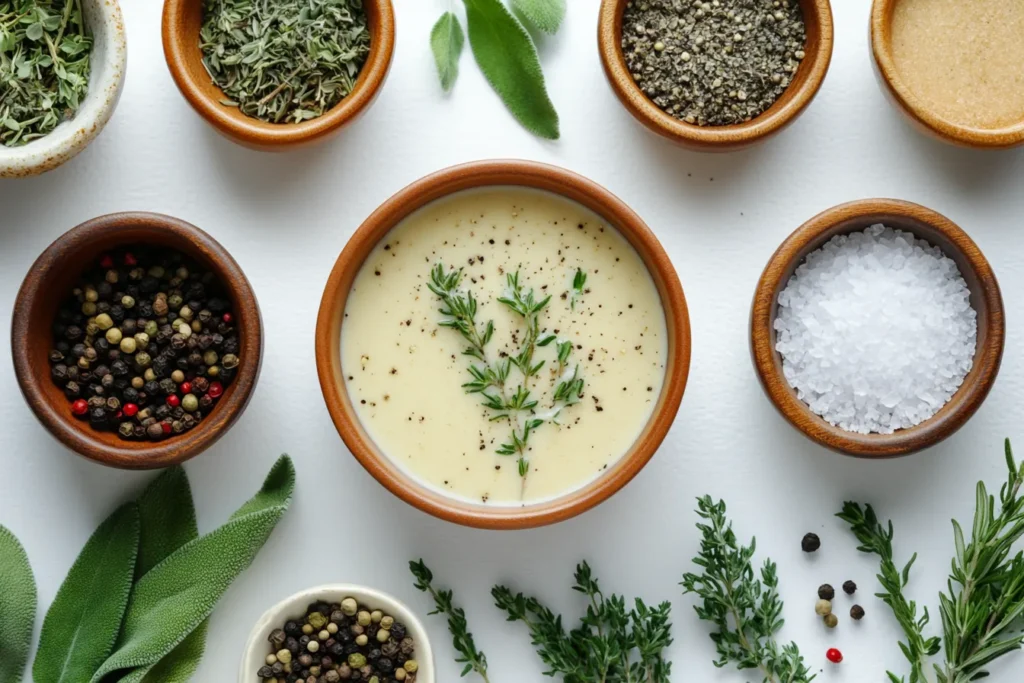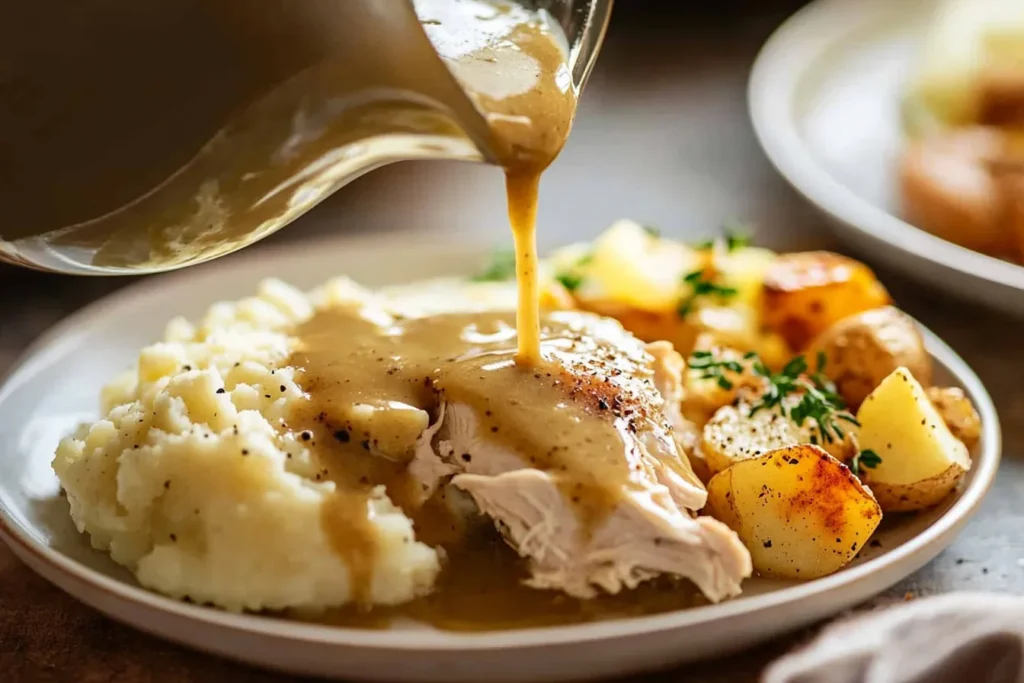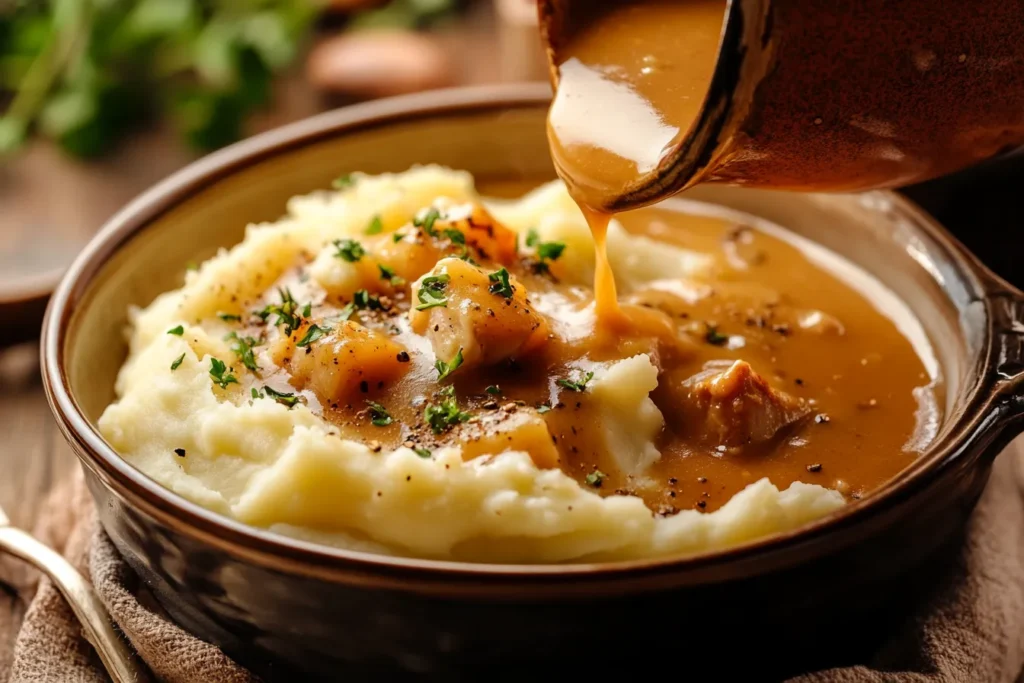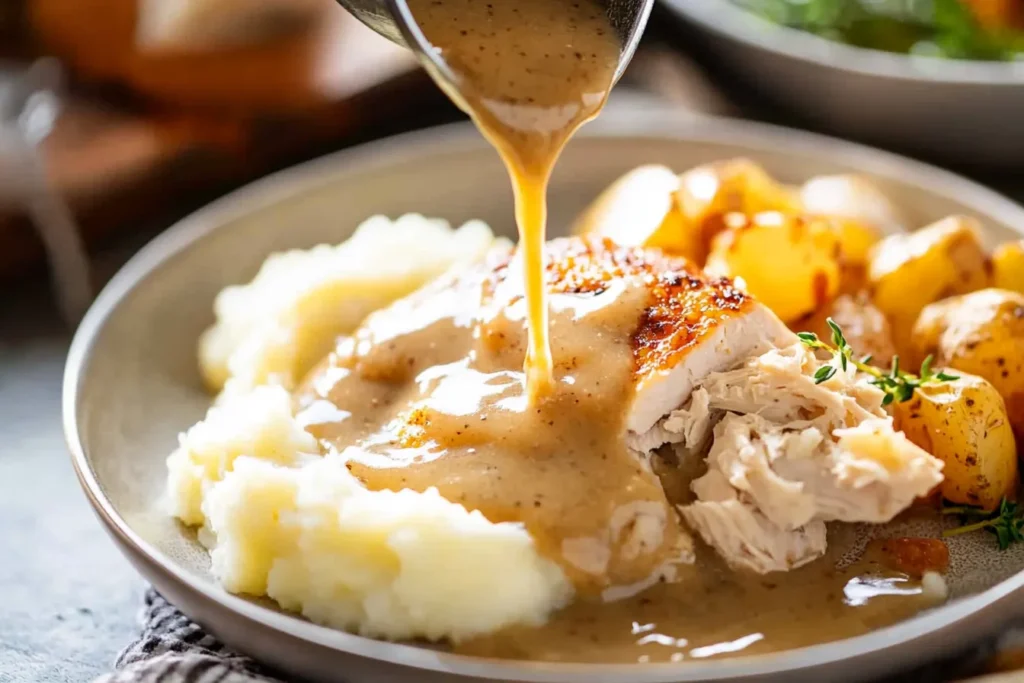Table of Contents
How can I make chicken gravy taste better? This is a question that plagues many home cooks aiming for that perfect, comforting side dish. Luckily, transforming ordinary gravy into an extraordinary culinary experience is achievable with a few simple techniques and a dash of creativity.
The Amazing Fundamentals of Chicken Gravy
Chicken gravy, at its core, is a sauce made from chicken drippings, flour, and broth. However, the magic lies in the details. Understanding the building blocks is crucial to elevating your gravy game. Let’s look into the intricacies of gravy preparation and find out just how to make a delicious chicken gravy (How can I make chicken gravy taste better?).
Starting with the Right Base
The foundation of any great chicken gravy is the pan drippings. Don’t discard those flavorful remnants after roasting or pan-frying your chicken! These drippings are packed with rendered fat and concentrated chicken flavor. If you don’t have enough drippings, supplement with melted butter or chicken fat for richness. The more flavorful your base, the more delicious your gravy will be (How can I make chicken gravy taste better?).
Mastering the Roux
The roux, a mixture of fat and flour, is the thickening agent for your gravy. The ratio is typically equal parts fat to flour. Cook the roux over medium heat, stirring constantly, until it reaches a light golden brown color. This process, known as “toasting” the flour, eliminates its raw taste and adds depth of flavor to the gravy. Be cautious not to burn the roux, or your gravy will taste bitter.
Selecting the Perfect Broth
Chicken broth is the liquid component that brings the gravy together. Use a high-quality chicken broth for the best flavor. Homemade broth is ideal, but store-bought options can work in a pinch. Low-sodium broth is preferable so you can control the salt level yourself. You can use chicken stock, but this may result in a richer, heavier gravy (How can I make chicken gravy taste better?).
Seasoning with Skill
Seasoning is where you can truly customize your chicken gravy. Salt and pepper are essential, but don’t be afraid to experiment with other flavors. Fresh herbs like thyme, rosemary, and sage add an earthy aroma. A pinch of garlic powder or onion powder can enhance the savory notes. A splash of Worcestershire sauce adds depth and umami (How can I make chicken gravy taste better?).

Incredible Techniques to Make Chicken Gravy Taste Better
Now that we’ve covered the fundamentals, let’s delve into specific techniques to elevate your chicken gravy from good to exceptional. These secrets are surprisingly simple, yet they make a world of difference (How can I make chicken gravy taste better).
Deglazing the Pan
Deglazing is a technique that involves using liquid to scrape up the browned bits stuck to the bottom of the pan after cooking the chicken. These browned bits, known as fond, are packed with concentrated flavor. Add chicken broth, wine (white or sherry), or even a splash of apple cider vinegar to the pan and scrape up the fond with a wooden spoon. This flavorful liquid then becomes part of your gravy.
Infusing with Aromatics
Aromatics like onions, garlic, celery, and carrots can add depth and complexity to your chicken gravy. Sauté these vegetables in the pan before making the roux. Their flavors will infuse the fat, creating a more flavorful base for your gravy. Remove the vegetables before adding the broth, or leave them in for a heartier gravy (How can I make chicken gravy taste better?).
Adding a Touch of Acid
A touch of acid can brighten the flavor of chicken gravy and balance the richness. A squeeze of lemon juice, a splash of white wine vinegar, or a dash of hot sauce can work wonders. Add the acid towards the end of cooking, tasting as you go to achieve the perfect balance.
Incorporating Herbs and Spices
Fresh herbs and spices can transform ordinary chicken gravy into a fragrant and flavorful masterpiece. Thyme, rosemary, sage, parsley, and chives are all excellent choices. Add dried herbs early in the cooking process to allow their flavors to fully develop. Add fresh herbs towards the end of cooking to preserve their bright aroma. Smoked paprika can add a savory element, while a touch of nutmeg can be very flavorful (How can I make chicken gravy taste better?).
Using Cream or Milk (Optional)
For a richer and creamier chicken gravy, add a splash of heavy cream or milk at the end of cooking. This will give the gravy a velvety texture and a luxurious mouthfeel. Be careful not to boil the gravy after adding cream or milk, as it may curdle (How can I make chicken gravy taste better?).
Straining for Smoothness
For a perfectly smooth gravy, strain it through a fine-mesh sieve after cooking. This will remove any lumps or solids, resulting in a silky-smooth texture. This is especially useful if you’re not using an immersion blender (How can I make chicken gravy taste better?).
The Secret of Umami
Umami, the fifth taste, adds a savory depth to chicken gravy. Ingredients like soy sauce, Worcestershire sauce, mushroom powder, or even a small amount of MSG can boost the umami flavor. Use these ingredients sparingly, tasting as you go, to avoid overpowering the other flavors.
Avoid These Terrible Chicken Gravy Mistakes

While there are many ways to enhance chicken gravy, there are also some common pitfalls to avoid. These mistakes can ruin your gravy, so it’s important to be aware of them.
Not Cooking the Roux Long Enough
A raw-tasting roux is one of the most common mistakes in gravy making. Be sure to cook the roux until it reaches a light golden brown color. This process eliminates the raw flour taste and adds depth of flavor (How can I make chicken gravy taste better?).
Burning the Roux
On the other hand, burning the roux will also ruin your gravy. Burnt roux tastes bitter and unpleasant. Keep the heat at medium and stir constantly to prevent burning.
Using Too Much Flour
Using too much flour will result in a thick, pasty gravy. Measure the flour carefully and use the correct ratio of fat to flour. If your gravy is too thick, add more broth to thin it out.
Not Seasoning Properly
Under-seasoned gravy tastes bland and unappetizing. Season generously with salt, pepper, and other herbs and spices. Taste as you go and adjust the seasonings to your liking.
Lumpy Gravy
Lumpy gravy is a common problem, but it can be avoided with a few simple techniques. Gradually whisk the broth into the roux, stirring constantly to prevent lumps from forming. If lumps do form, use an immersion blender to smooth out the gravy or strain it through a fine-mesh sieve.
Troubleshooting Common Chicken Gravy Problems
Even with the best intentions, chicken gravy can sometimes present challenges. Here’s how to troubleshoot some common problems and get your gravy back on track.
Gravy is Too Thin
If your gravy is too thin, there are a few things you can do. The easiest solution is to simmer the gravy over low heat for a longer period, allowing it to reduce and thicken naturally. Alternatively, you can make a slurry by mixing a tablespoon of cornstarch or flour with a few tablespoons of cold water. Whisk the slurry into the gravy and simmer until thickened. Be careful not to add too much slurry, or the gravy may become gluey (How can I make chicken gravy taste better?).
Gravy is Too Thick
Conversely, if your gravy is too thick, simply add more chicken broth until it reaches the desired consistency. Add the broth gradually, stirring constantly, to avoid making the gravy too thin. You can also add a splash of milk or cream for a richer flavor (How can I make chicken gravy taste better?).
Gravy is Too Salty
If you accidentally add too much salt to your gravy, don’t panic! There are a few ways to salvage it. Add a pinch of sugar to help balance the saltiness. You can also add a splash of lemon juice or vinegar for acidity. If all else fails, add a peeled potato to the gravy and simmer for 15-20 minutes. The potato will absorb some of the excess salt. Remove the potato before serving.
Gravy is Bland
A bland gravy is a common problem, but it’s easily fixable. Start by adding more salt and pepper. Then, experiment with other seasonings like garlic powder, onion powder, herbs, and spices. A splash of Worcestershire sauce or soy sauce can also add depth of flavor. Remember to taste as you go and adjust the seasonings to your liking (How can I make chicken gravy taste better?).
Serving Suggestions and Creative Variations

Now that you’ve mastered the art of making delicious chicken gravy, let’s explore some serving suggestions and creative variations to take your gravy game to the next level.
Classic Chicken and Gravy
The most classic way to serve chicken gravy is over mashed potatoes with roasted or fried chicken. This is a simple yet satisfying meal that is sure to please everyone.
Chicken Pot Pie
Chicken gravy is a key ingredient in chicken pot pie. Use your homemade gravy as the base for the filling, adding vegetables like carrots, peas, and potatoes. Top with a flaky pie crust and bake until golden brown (How can I make chicken gravy taste better?).
Biscuits and Gravy
Chicken gravy can also be served over biscuits for a hearty and comforting breakfast or brunch. Use your homemade gravy as the sauce and top with crumbled sausage or bacon for added flavor (How can I make chicken gravy taste better?).
Chicken and Waffles
For a sweet and savory twist, serve chicken and gravy over waffles. This is a popular dish that combines the richness of the gravy with the sweetness of the waffles (How can I make chicken gravy taste better?).
Mushroom Chicken Gravy
Add sautéed mushrooms to your chicken gravy for a flavorful and earthy variation. Use a variety of mushrooms like cremini, shiitake, and oyster for the best flavor.
How Can I Make Chicken Gravy Taste Better? Conclusion
In conclusion, how can I make chicken gravy taste better? By following these incredible secrets and avoiding common mistakes, you can create a chicken gravy that is truly unforgettable. From starting with a flavorful base to incorporating herbs and spices, there are countless ways to customize your gravy and make it your own. So, experiment with different flavors and techniques and discover your own secret to amazing chicken gravy.
FAQ
chicken and gravy recipe
A basic chicken and gravy recipe involves making a roux with butter and flour, then whisking in chicken broth and drippings. Season with salt, pepper, and herbs. Simmer until thickened. Many variations exist, including those using cream or different herbs.
What is in chicken gravy mix?
Chicken gravy mix typically contains flour, modified food starch, salt, hydrolyzed vegetable protein, dried chicken, rendered chicken fat, spices, onion powder, garlic powder, and disodium inosinate and guanylate (flavor enhancers).
What goes well with chicken and gravy?
Chicken and gravy pairs exceptionally well with mashed potatoes, biscuits, rice, noodles, stuffing, cornbread, and roasted vegetables like green beans or peas.
How to make a good chicken gravy?
To make a good chicken gravy, start with flavorful pan drippings, create a properly cooked roux, use high-quality chicken broth, season generously, and consider adding aromatics, herbs, or a touch of acid for extra depth.

